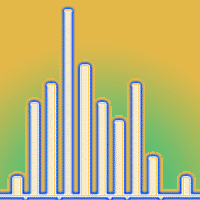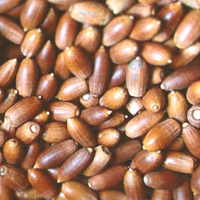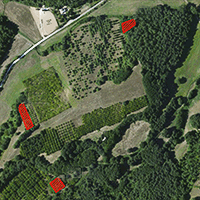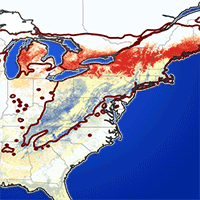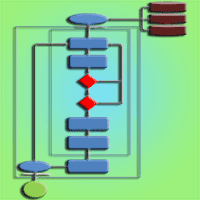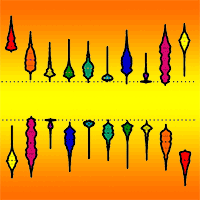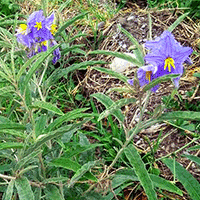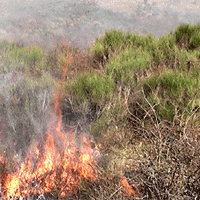Plant invasion in forest ecosystems is a serious ecological and economic issue, deserving attention by researchers, managers and policy-makers worldwide. Many invasive plants have been reported as early successional species able to colonize disturbed areas following abrupt changes in microhabitat and resource availability. We investigated disturbance effects of a severe windstorm generated by a wet microburst (hail and rain at 160 mm h-1) remarkably affecting the canopy cover of an old-growth Quercus ilex urban forest in Southern Italy. This stand-replacing disturbance produced a mosaic of 103 gaps, 5.6 to 1632 m2 in size, over an area of 1.53 ha, uprooting 76% of the trees and decreasing thereby 85% of the standing above-ground dry biomass into the gaps. By intensive monitoring we compared above- and below-ground microclimate, soil moisture and mineral N availability in paired disturbed and control areas of the study forest. Within newly formed gaps we observed a seasonally consistent 70% higher content of nitrate nitrogen, 29% and 47% decreases of ammonia nitrogen in summer and autumn, respectively, and a higher moisture in topsoil, in addition to different above- and below-ground microclimatic conditions, with canopy cover mitigating extreme temperatures. One year after the windstorm, the microhabitat shift promoted the establishment in gaps of 15 native and 10 alien taxa previously absent in both disturbed and control plots. In such conditions, the rarefaction of the dominant Q. ilex canopy cover and the occurrence of empty niches prone to invasion could dramatically affect the local community structure and diversity. Our data indicate that stand-replacing windstorm can transiently transform the studied urban evergreen forest to an early allogenic successional community dominated, in the medium and large gaps, by annual and perennial non-native species. This is particularly relevant under a perspective of possible increasing frequency of windstorm events in the Mediterranean region in the near future.
Keywords
, , , , ,
Citation
Bonanomi G, Incerti G, Abd El-Gawad AM, Sarker TC, Stinca A, Motti R, Cesarano G, Teobaldelli M, Saulino L, Cona F, Chirico GB, Mazzoleni S, Saracino A (2018). Windstorm disturbance triggers multiple species invasion in an urban Mediterranean forest. iForest 11: 64-71. - doi: 10.3832/ifor2374-010
Academic Editor
Michele Carbognani
Paper history
Received: Jan 23, 2017
Accepted: Nov 18, 2017
First online: Jan 25, 2018
Publication Date: Feb 28, 2018
Publication Time: 2.27 months
© SISEF - The Italian Society of Silviculture and Forest Ecology 2018
Open Access
This article is distributed under the terms of the Creative Commons Attribution-Non Commercial 4.0 International (https://creativecommons.org/licenses/by-nc/4.0/), which permits unrestricted use, distribution, and reproduction in any medium, provided you give appropriate credit to the original author(s) and the source, provide a link to the Creative Commons license, and indicate if changes were made.

Breakdown by View Type
(Waiting for server response...)
Article Usage
Total Article Views: 50356
(from publication date up to now)
Breakdown by View Type
HTML Page Views: 42024
Abstract Page Views: 3670
PDF Downloads: 3581
Citation/Reference Downloads: 19
XML Downloads: 1062
Web Metrics
Days since publication: 2888
Overall contacts: 50356
Avg. contacts per week: 122.05
Article Citations
Article citations are based on data periodically collected from the Clarivate Web of Science web site
(last update: Mar 2025)
Total number of cites (since 2018): 21
Average cites per year: 2.63
Publication Metrics
by Dimensions ©
Articles citing this article
List of the papers citing this article based on CrossRef Cited-by.
(1)
Allegrezza M, Corti G, Cocco S, Pesaresi S, Chirico GB, Saracino A, Bonanomi G (2016)Microclimate buffering and fertility island formation during
Juniperus communis ontogenesis modulate competition-facilitation balance. Journal of Vegetation Science 27: 616-627.
CrossRef |
Gscholar
(2)
Alston KP, Richardson DM (2006)The roles of habitat features, disturbance, and distance from putative source populations in structuring alien plant invasions at the urban/wildland interface on the Cape Peninsula, South Africa. Biological Conservation 132: 183-198.
CrossRef |
Gscholar
(3)
Arellano-Cataldo G, Smith-Ramírez C (2016)Establishment of invasive plant species in canopy gaps on Robinson Crusoe Island. Plant Ecology 217: 289-302.
CrossRef |
Gscholar
(4)
Bais HP, Vepachedu R, Gilroy S, Callaway RM, Vivanco JM (2003)Allelopathy and exotic plant invasion: from molecules and genes to species interactions. Science 301: 1377-1380.
CrossRef |
Gscholar
(5)
Bellot J, Avila A, Rodrigo A (1999)Throughfall and stemflow. In: “Ecology of Mediterranean evergreen oak forests” (Rodà F, Retana J, Gracia CA, Bellot J eds). Springer, Berlin Heidelberg, Germany, pp. 209-222.
CrossRef |
Gscholar
(6)
Blair BC, Letourneau DK, Bothwell SG, Hayes GF (2010)Disturbance, resources, and exotic plant invasion: gap size effects in a redwood forest. Madroño 57: 11-19.
CrossRef |
Gscholar
(7)
Bonanomi G, Capodilupo M, Incerti G, Mazzoleni S (2014)Nitrogen transfer in litter mixture enhances decomposition rate, temperature sensitivity, and C quality changes. Plant and Soil 381: 307-321.
CrossRef |
Gscholar
(8)
Celesti-Grapow L, Alessandrini A, Arrigoni PV, Banfi E, Bernardo L, Bovio M, Brundu G, Cagiotti MR, Camarda I, Carli E, Conti F, Fascetti S, Galasso G, Gubellini L, La Valva V, Lucchese F, Marchiori S, Mazzola P, Peccenini S, Poldini L, Pretto F, Prosser F, Siniscalco C, Villani MC, Viegi L, Wilhalm T, Blasi C (2009)Inventory of the non-native flora of Italy. Plant Biosystems 143: 386-430.
CrossRef |
Gscholar
(9)
Davis MA, Grime JP, Thompson K (2000)Fluctuating resources in plant communities: a general theory of invasibility. Journal of Ecology 88: 528-534.
CrossRef |
Gscholar
(10)
Denslow JS, Ellison AM, Sanford RE (1998)Treefall gap size effects on above- and below-ground processes in a tropical wet forest. Journal of Ecology 86: 597-609.
CrossRef |
Gscholar
(11)
Diodato N, Bellocchi G, Romano N, Chirico GB (2011)How the aggressiveness of rainfalls in the Mediterranean lands is enhanced by climate change. Climatic Change 108: 591-599.
CrossRef |
Gscholar
(12)
Dupont S, Pivato D, Brunet Y (2015)Wind damage propagation in forests. Agricultural and Forest Meteorology 214: 243-251.
CrossRef |
Gscholar
(13)
Ehrenfeld JG (2003)Effects of exotic plant invasions on soil nutrient cycling processes. Ecosystems 6: 503-523.
CrossRef |
Gscholar
(14)
Frelich LE, Lorimer CG (1991)Natural disturbance regimes in hemlock-hardwood forests of the upper Great Lakes region. Ecological Monograph 61: 145-164.
CrossRef |
Gscholar
(15)
Gray AN, Spies TA, Easter MJ (2002)Microclimatic and soil moisture responses to gap formation in coastal Douglas-fir forests. Canadian Journal of Forest Research 32: 332-343.
CrossRef |
Gscholar
(16)
Hierro JL, Eren O, Khetsuriani L, Diaconu A, Török K, Montesinos D, Andonian K, Kikodze D, Janoian L, Villarreal D (2009)Germination responses of an invasive species in native and non-native ranges. Oikos 118: 529-538.
CrossRef |
Gscholar
(17)
Hobbs RJ, Huenneke LF (1992)Disturbance, diversity, and invasion: implications for conservation. Conservation Biology 6: 324-337.
CrossRef |
Gscholar
(18)
Hulme PE, Pyšek P, Nentwig W, Vilà M (2009)Will threat of biological invasions unite the European Union. Science 324: 40-41.
CrossRef |
Gscholar
(19)
Jonikavičius D, Mozgeris G (2013)Rapid assessment of wind storm-caused forest damage using satellite images and stand-wise forest inventory data. iForest 6: 150-155.
CrossRef |
Gscholar
(20)
Keller RP, Geist J, Jeschke JM, Kühn I (2011)Invasive species in Europe: ecology, status, and policy. Environmental Sciences Europe 23: 1-17.
CrossRef |
Gscholar
(21)
Lepart J, Debussche M (1991)Invasion processes as related to succession and disturbance. In: “Biogeography of Mediterranean Invasions” (Groves RH, Di Castri F eds). Cambridge University Press, Cambridge, UK, pp. 159-178.
CrossRef |
Gscholar
(22)
Li J, Romane FJ (1997)Effects of germination inhibition on the dynamics of
Quercus ilex stands. Journal of Vegetation Science 8: 287-294.
CrossRef |
Gscholar
(23)
Lugo AE (2008)Visible and invisible effects of hurricanes on forest ecosystems: an international review. Austral Ecology 33: 368-398.
CrossRef |
Gscholar
(24)
MacArthur RH (1970)Species packing and competitive equilibrium for many species. Theoretical Population Biology 1: 1-11.
CrossRef |
Gscholar
(25)
Mazzoleni S, Bonanomi G, Incerti G, Chiusano ML, Termolino P, Mingo A, Lanzotti V (2015)Inhibitory and toxic effects of extracellular self-DNA in litter: a mechanism for negative plant-soil feedbacks? New Phytologist 205: 1195-1210.
CrossRef |
Gscholar
(26)
McKinney ML (2006)Urbanization as a major cause of biotic homogenization. Biological Conservation 127: 247-260.
CrossRef |
Gscholar
(27)
Mitchell S (2013)Wind as a natural disturbance agent in forests: a synthesis. Forestry 2: 147-157.
CrossRef |
Gscholar
(28)
Murdoch AJ, Ellis RH (2000)Dormancy, viability and longevity. In: “Seeds: the ecology of regeneration in plant communities (2nd edn)” (Fenner M ed). CABI Publishing, Wallingford, UK, pp. 183-214.
CrossRef |
Gscholar
(29)
Murphy HT, Metcalfe DJ, Bradford MG, Ford A, Galway K, Sydes T, Westcott D (2008)Recruitment dynamics of invasive species in rainforest habitats following Cyclone Larry. Austral Ecology 33: 495-502.
CrossRef |
Gscholar
(30)
Peterson CJ (2000)Catastrophic wind damage to North American forests and the potential impact of climate change. Science of the Total Environment 262: 287-311.
CrossRef |
Gscholar
(31)
Pimentel D (2011)Biological invasions: economic and environmental costs of alien plant, animal, and microbe species. CRC Press, Boca Raton, USA, pp. 463.
Online |
Gscholar
(32)
Poulson TL, Platt WJ (1989)Gap light regimes influence canopy tree diversity. Ecology 70: 553-555.
CrossRef |
Gscholar
(33)
Richards CL, Bossdorf O, Muth NZ, Gurevitch J, Pigliucci M (2006)Jack of all trades, master of some? On the role of phenotypic plasticity in plant invasions. Ecology Letters 9: 981-993.
CrossRef |
Gscholar
(34)
Ritter E, Dalsgaard L, Einhorn KS (2005)Light, temperature and soil moisture regimes following gap formation in a semi-natural beech-dominated forest in Denmark. Forest Ecology and Management 206: 15-33.
CrossRef |
Gscholar
(35)
Romano B, Zullo F (2014)Land urbanization in Central Italy: 50 years of evolution. Journal of Land Use Science 9: 143-164.
CrossRef |
Gscholar
(36)
Schaetzl RJ (1986)Complete soil profile inversion by tree uprooting. Physical Geography 7: 181-189.
Online |
Gscholar
(37)
Seidl R, Schelhaas M-J, Rammer W, Verkerk PJ (2014)Increasing forest disturbances in Europe and their impact on carbon storage. Nature Climate Change 4: 806-810.
CrossRef |
Gscholar
(38)
Stinca A, Motti R (2009)The vascular flora of the Royal Park of Portici (Naples, Italy). Webbia 64: 235-266.
CrossRef |
Gscholar
(39)
Szmyt J, Dobrowolska D (2016)Spatial diversity of forest regeneration after catastrophic wind in northeastern Poland. iForest 9: 414-421.
CrossRef |
Gscholar
(40)
Tabacchi G, Di Cosmo L, Gasparini P, Morelli S (2011)Stima del volume e della fitomassa delle principali specie forestali italiane. Equazioni di previsione, tavole del volume e tavole della fitomassa arborea epigea [Volume and phytomass estimation of the main Italian forest species. Forecast equations, tables of volume and of above ground phytomass]. Consiglio per la Ricerca e la sperimentazione in Agricoltura, Unità di Ricerca per il Monitoraggio e la Pianificazione Forestale, Trento, Italy, pp. 343-356. [in Italian]
Gscholar
(41)
Traveset A, Richardson DM (2006)Biological invasions as disruptors of plant reproductive mutualisms. Trends in Ecology and Evolution 21: 208-216.
CrossRef |
Gscholar
(42)
Turner MG (2010)Disturbance and landscape dynamics in a changing world. Ecology 91: 2833-2849.
CrossRef |
Gscholar
(43)
Tutin TG (1980)Flora Europaea, vol 1-5. Cambridge University Press, Cambridge, UK, pp. 476.
Online |
Gscholar
(44)
Vandermeer J, De La Cerda IG (2004)Height dynamics of the thinning canopy of a tropical rain forest: 14 years of succession in a post-hurricane forest in Nicaragua. Forest Ecology and Management 199: 125-135.
CrossRef |
Gscholar
(45)
Vázquez-Yanes C, Orozco-Segovia A, Rincon EEA, Sanchez-Coronado ME, Huante P, Toledo JR, Barradas VL (1990)Light beneath the litter in a tropical forest: effect on seed germination. Ecology 71: 1952-1958.
CrossRef |
Gscholar
(46)
Wang C, Xiao H, Liu J, Wang L, Du D (2015)Insights into ecological effects of invasive plants on soil nitrogen cycles. American Journal of Plant Sciences 6: 34-46.
CrossRef |
Gscholar
(47)
Whitmore TC (1989)Canopy gaps and two major groups of forest trees. Ecology 70: 536-538.
CrossRef |
Gscholar
(48)
Zimmerman JK, Pulliam WM, Lodge DJ, Quiñones-Orfila V, Fetcher N, Guzman-Grajales S, Parrotta JA, Asbury CE, Walker LR, Waide RB (1995)Nitrogen immobilization by decomposing woody debris and the recovery of tropical wet forest from hurricane damage. Oikos 72: 314-322.
CrossRef |
Gscholar


